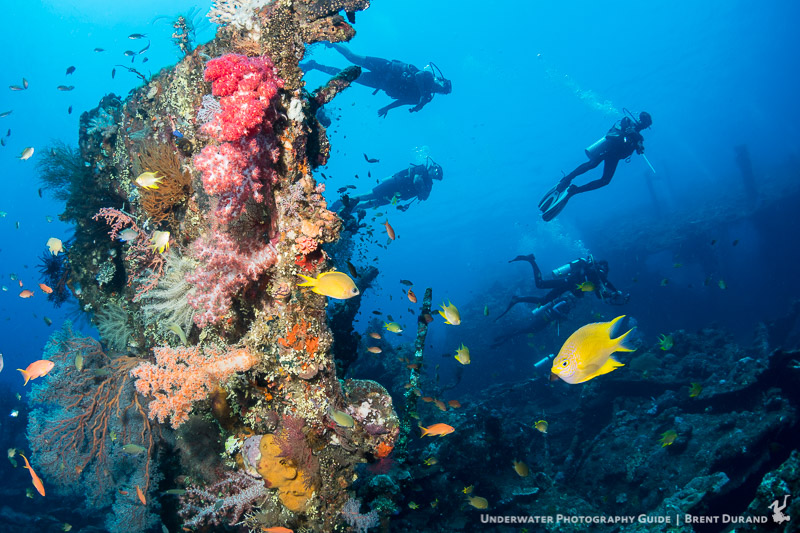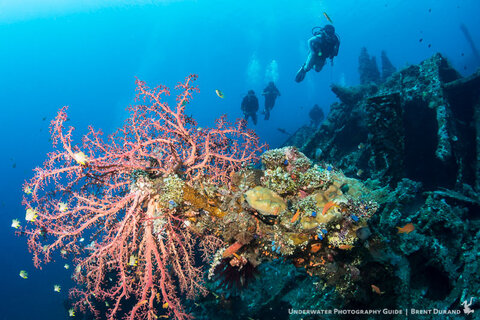
Sometimes our creative inspiration comes from difficulties with gear in the field. This is the time when a solid understanding of the principals of photography might help save the shoot, the dive, and even the trip. During the recent Bluewater Photo workshop in Bali, Indonesia, the bulb on one of my YS-D1 strobes bulbs blew on day one. I heard the pop and was immediately bummed thinking of all the diving left in the trip, plus my desire to get some great shots with the new Sony a6300 mirrorless camera.
Luckily, Bluewater Photo put a rental YS-D2 strobe in the mail that next day, but I still had a week of single strobe wide-angle shooting to do while the replacement strobe was in transit. Challenge accepted!
Ambient Light vs. Artificial Light
Before trying to combine our strobe and video light sources into one frame, we need to understand a little bit about light sources and the camera settings required to capture light from those sources. We work on this during photo workshops but have summed the principals up below.
Ambient light (aka available light) is light that the camera sees. Generally we think of this as sunlight shining through the water from above, but for shooting photos we can also include video light as ambient light. Why? Because the settings to capture the light from the sun and the video light will be the same. The ambient light illuminates the mid-ground and back-ground of the composition, while the video light illuminates the subject in the foreground.
Artificial light will come from our strobe. And yes, a video light can be viewed as artificial, but that’s a different line of thought from this discussion.

Settings to Combine Light Sources
Now that we understand the light sources we can figure out the best camera settings for combining them. To do this, we start with ambient light. Keep in mind that we’re close to the subject, but not shooting close focus wide-angle. A good starting point is a low ISO (100 on compact, 100-200 mirrorless/dslr), 1/100 shutter speed, and aperture of f/5.6 (compact) or f/8 – f/11 (mirrorless/dslr). Check the histogram to make sure that the exposure is metering where you want it, and that you’re seeing the ambient light from your video light illumating the foreground from that direction. Usually 1/125s is a great starting point for wide-angle with strobes, but when we want to include video light, we slow down the shutter at least 1/3 stop to let in more ambient light. These shots all were all using 1/100 or 1/80s at depths of 50-75ft (15-23m).
Next, we add our artificial strobe light. The strobe will generally be set to 1/2 – 3/4 power (preferably on manual, otherwise on TTL with no flash exposure comp). When we push the shutter, the strobe should illuminate most of the foreground, the video light should fill in the shadows, and the blue water and structure in the background should be a nice blue color. Bam!
Finding the Right Composition
So why do we want to combine strobe and video light in the first place? Because a single light source will deliver very strong shadows on the subject when shooting wide-angle, even with a diffuser.
The lumen rating of your video light will determine how much water the light will shine through, and with my I-Torch Venom 38 (3800 lumens) I liked to stay within a couple feet for my shots. At this range the video light would appear in the images, filling in the shadows of the strobe.
Ideally, you will find a foreground that is not too large, which would be difficult to light completely.

Learn More, Shoot More
Want to improve your underwater photography technique and composition? Join me for a workshop in 2017! You can email Bluewater Travel or look at the spots left on our Sri Lanka Wrecks and Reefs liveaboard trip in February ’17.












